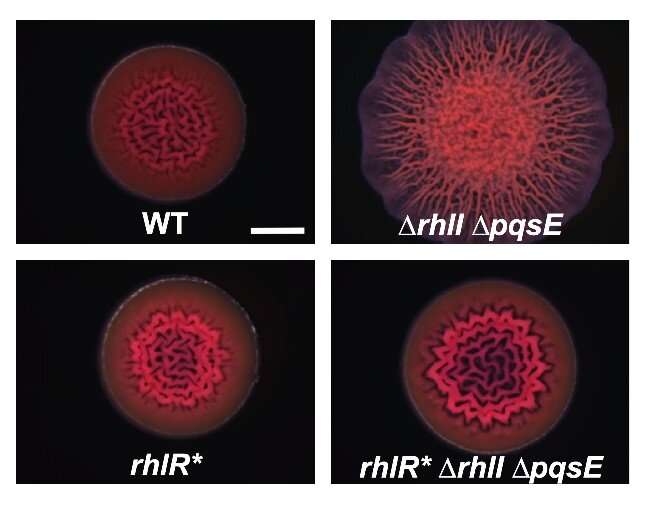RhlR* stimulates colony biofilm formation in P. aeruginosa in the absence of an autoinducer. Colony biofilm phenotypes of the designated P. aeruginosa strains following growth for 120 hours on tryptone Congo-red medium. Scale bar is 2 mm for all images. Images are representative of three biological replicates and two technical replicates for each biological replicate. Credit: McCready AR, et al. (2019)
Researchers have developed a new mutant version of a receptor used by a bacterial pathogen for a chemical communication process called quorum sensing, according to a study published June 13 in the open-access journal PLOS Pathogens by Bonnie Bassler of Princeton University, and colleagues. As the authors note, the mutant receptor could be used to identify therapeutic compounds that inhibit quorum sensing, fulfilling an urgent medical need.
The human pathogen Pseudomonas aeruginosa uses quorum sensing to orchestrate group behaviors, including biofilm formation and the production of infection-promoting molecules called virulence factors. Quorum sensing, which is essential for P. aeruginosa to be a pathogen, relies on the production, release, and detection of extracellular signal molecules called autoinducers. Autoinducers are bound by partner receptor proteins, and together, autoinducer-receptor complexes activate the transcription of quorum-sensing genes. In the new study, Bassler and colleagues identify, purify, and characterize a mutant version of the P. aeruginosa RhlR quorum-sensing receptor, which they call RhlR*.
Remarkably, RhlR* does not require its partner autoinducer to function. P. aeruginosa carrying RhlR* can properly form biofilms, produce virulence factors, and infect roundworms. Because RhlR* does not rely on an autoinducer to function, biochemical and genetic analyses that were previously not possible with RhlR could be performed with RhlR*. The findings provide new insight into the workings of other P. aeruginosa quorum-sensing components, most notably, the PqsE enzyme that functions together with RhlR to control virulence factor production. The authors propose that RhlR* is an especially valuable tool for learning about cell-cell communication and virulence in P. aeruginosa, a pathogen of high clinical relevance.
The authors add, "To our knowledge, this is the first report of a quorum-sensing receptor of this class that functions without its partner autoinducer molecule, opening up entirely new possibilities for study of virulence in Pseudomonas aeruginosa, a globally important pathogen."
More information: McCready AR, Paczkowski JE, Cong J-P, Bassler BL (2019) An autoinducer-independent RhlR quorum-sensing receptor enables analysis of RhlR regulation. PLoS Pathog 15(6): e1007820. doi.org/10.1371/journal.ppat.1007820
Journal information: PLoS Pathogens
Provided by Public Library of Science






















